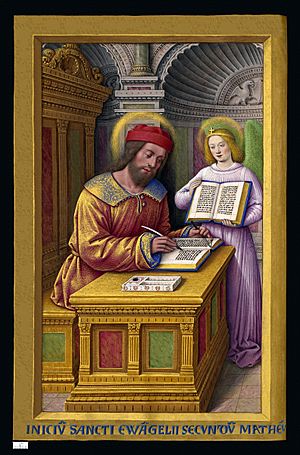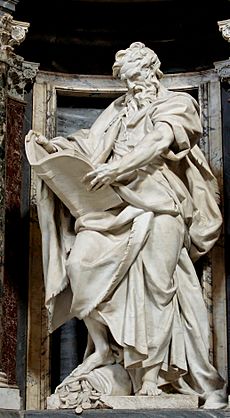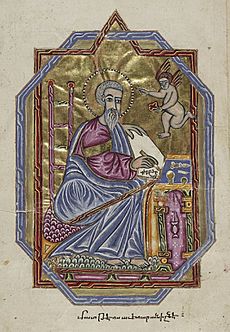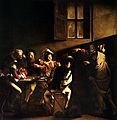Matthew the Apostle facts for kids
Quick facts for kids SaintMatthew the Apostle |
|
|---|---|

Matthew the Evangelist, miniature from the Grandes Heures of Anne of Brittany, Queen consort of France (1477–1514)
|
|
| Apostle, Evangelist, and Martyr | |
| Born | 1st century AD Capernaum |
| Died | 1st century AD near Hierapolis or Ethiopia, relics in Salerno, Italy |
| Venerated in | Eastern Orthodox Church Catholic Church Eastern Catholic Churches Oriental Orthodoxy Church of the East Anglican Communion Lutheranism |
| Canonized | Pre-Congregation |
| Feast | 21 September (Western Christianity) 22 October (Coptic Orthodox) 16 November (Eastern Christianity) |
| Attributes | Angel |
| Patronage | Accountants; Salerno, Italy; bankers; tax collectors; perfumers; civil servants |
| Major works | Gospel of Matthew |
Matthew the Apostle, also known as Saint Matthew or Levi, was an important person in early Christianity. He was one of the twelve main followers of Jesus. Many Christian traditions also say he was one of the Four Evangelists, meaning he wrote one of the four Gospels in the Bible. Because of this, he is also called Matthew the Evangelist.
The New Testament tells us that Matthew followed Jesus and saw Him go up to heaven (this event is called the Ascension of Jesus). Early Christian leaders believed that Matthew first shared Jesus' message with Jewish people in Judea. Later, he traveled to other countries to preach.
Contents
Matthew in the Bible
The Bible mentions Matthew as one of Jesus' first followers. He was a tax collector in a town called Capernaum. Tax collectors were often disliked because they worked for the Roman government, which ruled the area.
One day, Jesus saw Matthew (who was also called Levi) sitting at his tax booth. Jesus simply said, "Follow me." Matthew immediately left his work and followed Jesus. He is also listed as one of the twelve apostles in the books of Mark, Luke, and Acts.
Matthew's Early Life
The Gospels say that Matthew was from Galilee, a region that was not part of the main Roman province of Judea. His father's name was Alphaeus. As a tax collector, Matthew would have been able to read and write, which was useful for his job. However, many Jewish people at the time looked down on tax collectors. They saw them as working with the Roman rulers, who were seen as occupiers.
After Matthew started following Jesus, he invited Jesus and His followers to a big dinner at his house. Many other tax collectors and people considered "sinners" were also there. Some religious leaders, called Pharisees, saw this and criticized Jesus for eating with such people. Jesus replied, "I did not come to call good people, but sinners to change their ways."
Matthew's Work as a Disciple
As a disciple, Matthew stayed with Jesus and saw many of His miracles and teachings. He was also present when Jesus ascended into heaven. After Jesus left, Matthew and the other disciples gathered in Jerusalem. They continued to spread the message that Jesus was the promised Messiah.
Some early Christian writers, like Irenaeus and Clement of Alexandria, believed that Matthew first preached to Jewish communities in Judea. Then, they say he traveled to other countries. The Catholic Church and the Eastern Orthodox Church believe that Matthew died as a martyr, meaning he was killed for his faith.
The Gospel of Matthew

The Gospel of Matthew is one of the four Gospels in the New Testament. It tells the story of Jesus' life, teachings, death, and resurrection. The author of the Gospel is not named in the book itself. However, early Christian tradition says that the apostle Matthew wrote it.
An early Christian leader named Papias, who lived around 60-163 AD, wrote that "Matthew collected the sayings of Jesus in the Hebrew language." This led some to believe that Matthew's Gospel was first written in Hebrew or Aramaic and then translated into Greek. However, most modern experts believe that the Gospel of Matthew we have today was originally written in Greek. It does not look like a translation from another language.
Many Bible scholars today think that the Gospel of Matthew was not written directly by the apostle Matthew himself. Instead, they believe it was written by someone else who used Matthew's name to show respect for his teachings.
Other Writings About Matthew

In the early centuries of Christianity, some Jewish-Christian groups used other Gospels that were said to be by Matthew. These are called "non-canonical" or "apocryphal" Gospels because they are not part of the official Bible. Examples include the Gospel of the Nazarenes and the Gospel of the Ebionites. Only small parts of these writings still exist today.
One famous non-canonical book is the Infancy Gospel of Matthew. This book, written in the 7th century, tells stories about Jesus' childhood that are not found in the Bible.
Honoring Saint Matthew
Matthew is honored as a saint in many Christian churches, including the Catholic Church, Eastern Orthodox Church, Lutheran, and Anglican churches. His special day, or feast day, is celebrated on September 21 in Western churches and November 16 in Eastern churches.
Matthew's tomb is believed to be in the crypt (an underground room) of Salerno Cathedral in southern Italy.
In Christian art, Matthew is often shown with a winged man or an angel. This symbol comes from the Bible book of Revelation, where four living creatures are described. The winged man represents Matthew because his Gospel focuses on Jesus' human ancestry and birth.
Matthew in Islam
The Quran, the holy book of Islam, mentions Jesus' disciples but does not name them. However, Islamic scholars and commentators often name them, and Matthew is included among them. Some Islamic traditions say that Matthew and another disciple named Andrew traveled to a region called 'Ethiopia' (which was south of the Caspian Sea, not the African country) to share the message of God.
Images for kids
-
The Calling of St Matthew, 1599–1600, by Caravaggio
-
Saint Matthew and the Angel by Guido Reni, 1620–1630
See also
 In Spanish: Mateo el Evangelista para niños
In Spanish: Mateo el Evangelista para niños








